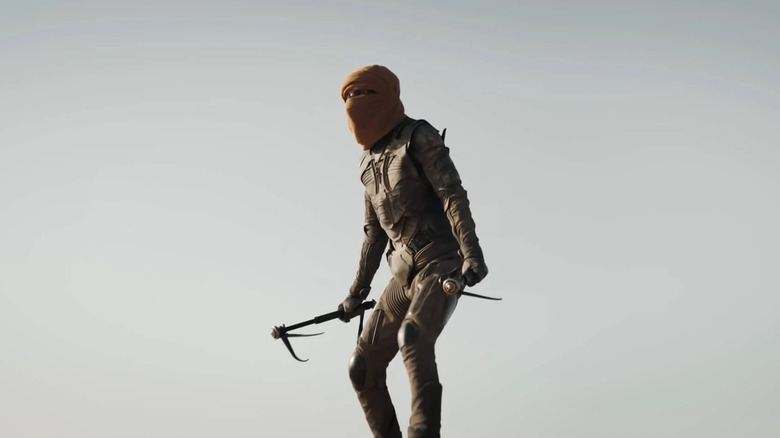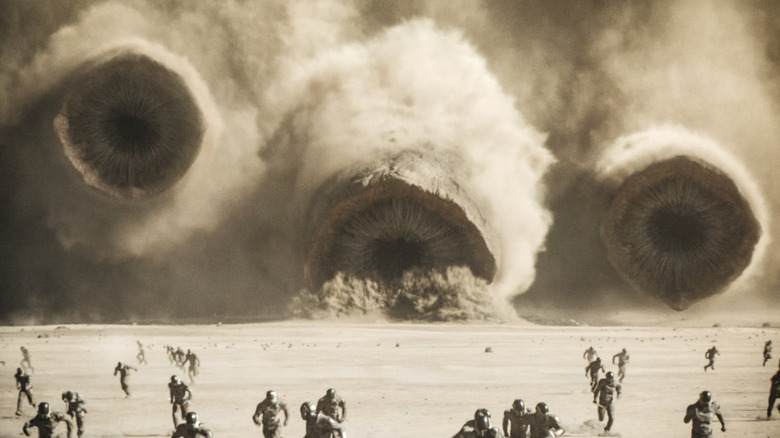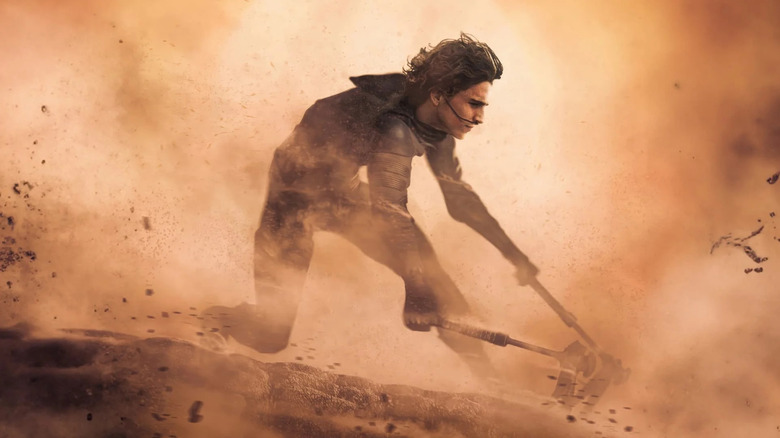How Fremen Get Down Off The Sandworms In Dune, According To The Books
Frank Herbert's "Dune" novels and their cinematic adaptations impressed two things upon pop culture consciousness that exist well beyond the franchise. One is that "the spice must flow," referring to the eternal need for spice melange, an incredibly powerful powder that powers starships and gives the Bene Gesserit their psychic abilities. The other is that sandworms, while terrifying, are also supremely cool. The idea of riding them around the desert like the galaxy's biggest, freakiest surfboards is even cooler. So it makes sense that one of the most epic scenes in Denis Villeneuve's "Dune: Part Two" features Paul Atreides (Timothy Chalamet) going through the Fremen rite of passage and catching a ride on his very first sandworm.
Villeneuve has compared sandworm travel to "a very, very intense Uber," though I'm pretty sure Uber drivers don't generally turn around and try to swallow you whole.
We get to see a fair bit of sandworm riding in "Dune: Part Two," but one thing we never see is how people disembark from their less-than-friendly mounts. It's not like you can just tell the sandworm to pull over at your stop, or park and roll up a set of those airplane-boarding stairs. So, how exactly does someone get off of a freaking sandworm once they've gotten on? The answer is in Herbert's follow-up novel to "Dune" and "Dune: Messiah," "Children of Dune," and Villeneuve apparently has a plan on how exactly he would do it if he gets the chance to adapt "Dune: Messiah."
Dismounting from a sandworm is tricky business
In "Dune: Part Two," Paul hitches a ride with a sandworm by basically hailing the thing with a thumping tool and then jumping on its back with special climbing equipment called maker hooks ("maker" is another name for the sandworms, since the Fremen believe the creatures to be physical embodiments of their god). The sequence is harrowing stuff because the sandworm is moving fast enough that a misstep could spell a broken neck, but Paul manages just fine. Once the hooks are in place, they pull back the thick dorsal plates and expose the sensitive flesh beneath, forcing the worm to remain on the surface of the sand instead of diving. A sandworm will strive to keep its exposed flesh on top, to prevent the sand from irritating it, which handily prevents them from rolling and throwing their rider off.
There are also palanquins that can be put on the backs of the worms for those who can't just jump on and hold on for dear life, which are attached once a Fremen has already established control over it. As far as climbing off of the worms, Villeneuve told Variety that he has a plan for how he would depict that potentially terrifying event:
"I knew how. I found a way. It was not dramatically necessary in 'Dune: Part Two' to see someone get out of the worm, but I know how to do it. And I can't wait to put that on screen."
Villeneuve has shown that he has no problems straying from the source material, making at least one pretty major change to "Dune" from the books, so he could have something totally different in mind, but Herbert did give a blueprint for sandworm debarking in "Children of Dune," and it sounds just as wild as riding those gargantuan invertebrates.
Tuck and roll, baby!
As detailed in a sequence in "Children of Dune" where Leto II (Paul and Chani's son) is riding a sandworm and needs to hop off, the Fremen basically just, well, hop off — ideally when the worm has tired itself out and won't be as likely to turn around and try and turn its rider into a snack. Leto uses his stilltent (basically an airtight sleeping bag) to protect himself as he drops off of the worm during a terrible sandstorm, slowing his breathing so he won't run out of air while he rides out the storm. He recalls hearing stories about worm-riders who succeeded in bringing their sandworm to a complete stop and anchoring it in place, but decides against risking this possibly mythical maneuver.
Another thing that "Children of Dune" reveals about the sandworms is that they're full of flames, as their insides run on heat and oxygen. That violent chemical exchange has to exit somewhere, and that means they're constantly expelling monstrous, superheated farts. In fact, there are children's stories teaching young Fremen about the dangers of the worm's tail just as much as its many-toothed head. As if they couldn't be any freakier.
Hopefully Villeneuve gets to make "Dune: Messiah" and really let loose with his idea — whether it's something a bit more complex, or just giving it a good old tuck and roll as riders leap into the sand. We will have to see, but with the impressive box office of "Dune: Part Two" thus far, it's looking pretty likely that we'll see even more giant worm rodeo riding, which rules.


